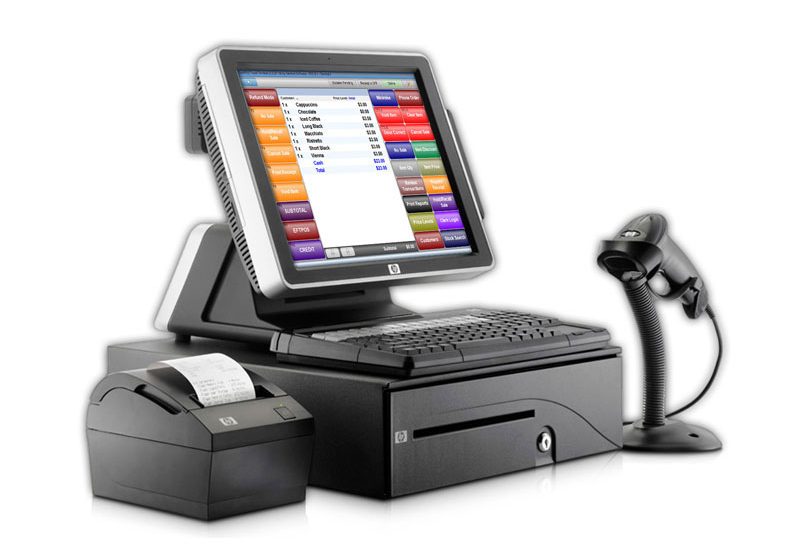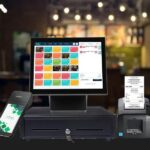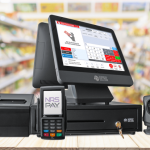- November 5, 2022
- Posted by: simba001
- Categories: Benefits of POS, POS Software in Kenya

Retail stores come in all shapes and sizes, but if there’s one thing every shop needs, it’s a solid point of sale (POS) system.
The POS plays a key role in any store’s day-to-day operations, as it drives the entire checkout process. You use your point of sale system to ring up sales, collect payments and ensure that transactions are processed efficiently.
But how does a POS system work, exactly?
What is a POS system?
A point of sale system (sometimes referred to as a “POS machine”) is the system you use to facilitate in-store sales. It also serves as your record-keeping solution for transactions, enabling you to track your revenue, inventory, customers and more.
POS systems can come in various forms. Some retailers may use a computer, along with additional hardware such as receipt printers and cash drawers (more on this below). Others simply use a mobile device—such as an iPad—as their POS.
The right setup depends on your needs and the checkout experience you want to provide.
What are the different parts of a POS system?
To better understand how a POS system works, we first need to discuss the different components a point of sale systems can have. These solutions are generally made of two key parts: software and hardware.
POS Software
POS software is the program or application that executes the various functions required at the point of sale. At the most basic level, POS software enables you to calculate transaction amounts, track sales and monitor inventory.
POS Hardware
Hardware includes the physical components of your point of sale system. Think of hardware as the body of your POS, while software is the mind. Below are the most common hardware used with a POS system.
POS terminal
This is the device on which the POS software runs. It can be a desktop computer, laptop or mobile device (e.g, smartphone or tablet). Some POS providers may offer specially-designed hardware that works with their proprietary software.
Card reader
If you accept credit card payments (and you totally should), you need a credit card reader to facilitate the payment processes. The type of credit card machine you need will depend on your point of sale software and terminal. Discuss your options with your provider to ensure you’re using card readers that are compatible with their solution.
Barcode scanner
Ideal for stores that have a large catalog, a barcode scanner saves you time from having to manually type or search for products. Just scan the barcode and your POS will automatically add the product to the transaction.
Receipt printer
If you provide physical receipts to shoppers, then you need a device to print those receipts. This is where the receipt printer comes in. When connected with your POS system, the printer will automatically produce a receipt when the transaction is complete.
Cash drawer
This device primarily holds cash, so you can cater to customers who prefer this payment method. Your cash drawer stores cash so you can collect payments and dispense change when necessary.
How does a POS system work?
We just covered the different components of a point of sale solution; now, let’s look at how they all come together. Here’s a step by step process of how a POS system works.
How a POS system works when ringing up sales
Point of sale systems are most visible during the checkout process, which typically involves the following steps.
Record the items being purchased.
First, the customer presents the items they want to purchase to the cashier. This usually means that the shopper brings the products to the checkout area, though some retailers can implement the checkout process on the sales floor.
From there, you (or your cashier) would record the items and quantities being purchased by scanning them into the POS (if there’s a barcode scanner). If you’re using a mobile POS or are transacting on the go (like at an event), then recording the item could mean typing it into the point of sale software.
The software will then record the purchase data (item name, quantity, etc.) and display the info on the screen.
Collect and process payment.
Once all items have been added to the sale, the cashier initiates the payment process by clicking or tapping the appropriate button on the POS display.
At this point, they would ask how the customer would like to pay. If they’re paying in cash, then the cashier would simply take the payment, open the cash drawer, put the cash inside and hand the customer their change (if needed).
If the customer is using a credit card then the cashier would select that payment method in the POS and prompt the customer to swipe, dip or tap their card using the credit card reader. The process is the same for mobile payments, but instead of using a physical card, the customer must hover their phone over the credit card terminal.
The card reader connects and interfaces with the POS system to securely collect the payment and process the transaction*
Generate a receipt.
Once the payment is approved, the POS system completes the sale and generates a receipt. Depending on your setup, this could involve printing a physical receipt or prompting the customer to enter their email or phone number so they can just have a digital copy.
Offer loyalty points and rewards [optional].
This is an additional step that takes place in retail stores that offer loyalty programs.
If you reward shoppers for their purchase, then your checkout process would involve a loyalty component, in which you ask customers to provide their details. This could be their email, phone number, birthday, or whatever info you use to track your loyalty program members.
As for when this step takes place, that depends on your POS setup. In most cases, loyalty points are recorded when the sale has been approved and before painting the receipt.
How a POS system works in the back office
The POS system is certainly a critical part of the checkout process, but let’s not forget that it also plays an equally important role in the back office.
While all of the steps we outlined above happen at the checkout counter, there are some essential functions that are taking place behind the scenes. They include:
Updating inventory levels.
As items are added to the sale, your POS system is busy tracking and recording those quantities in the background, and it updates your catalog accordingly.
So, if the customer purchases three pairs of socks, then your POS will update the quantity of that item so you always have an accurate record of what you have on-hand.
Depending on how your POS system works, it can also prompt you to reorder certain items if quantities fall below a certain threshold.
Recording revenue data.
Your point of sale software can also record all transactional data that goes through the system. This includes sales, payments, returns and more. The software tallies and organizes all that data, and in some cases can display them in a dashboard for easy reference.
If your point of sale solution is connected to your accounting software, then your POS can also sync financial data to help you stay on top of your books.
Updating customer data.
If you collect and track shopper data, your POS system can keep everything in check. This includes recording your customers’ contact info, purchase history, accumulated loyalty points and more.
All of the above enables you to make smarter decisions, empowering you to run your business more efficiently. Most POS systems have reporting capabilities that allow you track key metrics and have a handle on business performance at all times.
As you can see, the role of your POS goes beyond simply ringing up sales. The right system keeps your operations running smoothly and helps you and your team make smarter business decisions.
At SimbaPOS, our mission is to empower businesses for GROWTH by providing Affordable, Reliable and Easy to Use Point of Sale Systems. Contact us today on 0700 001779 for demo/installation or send Email





